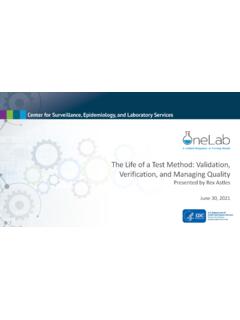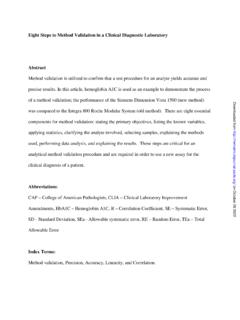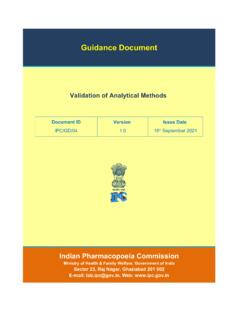Transcription of A Review on Step-by-Step Analytical Method Validation
1 IOSR Journal Of Pharmacy (e)-ISSN: 2250-3013, (p)-ISSN: 2319-4219 Volume 5, Issue 10 (October 2015), PP. 07-19 7 A Review on Step-by-Step Analytical Method Validation Panchumarthy Ravisankar*1, Ch. Naga Navya1, D. Pravallika1, D. Navya Sri1 1 Vignan Pharmacy College, Vadlamudi, Guntur (Dist.) - 522213, Andhra Pradesh State, India. Abstract: When Analytical Method is utilized to generate results about the characteristics of drug related samples it is essential that the results are trustworthy. They may be utilized as the basis for decisions relating to administering the drug to patients. Analytical Method Validation required during drug development and manufacturing and these Analytical methods are fit for their intended purpose. To comply with the requirements of GMP pharmaceutical industries should have an overall Validation policy which documents how Validation will be performed.
2 The purpose of this Validation is to show that processes involved in the development and manufacture of drug, production and Analytical testing can be performed in an effective and reproducible manner. This Review article provides guidance on how to perform Validation characteristics for the Analytical Method which are utilized in pharmaceutical analysis. Keywords: Analytical Method Validation , Pharmaceutical analysis, Specificity, Precision, Accuracy. I. INTRODUCTION It may be defined that Analytical chemistry is the study of separation, quantification and chemical components identification of natural and artificial materials constituted with one or more compounds or elements. Analytical chemistry is separated into two main categories, qualitative analysis that is to say the identification with regard to the chemical components exist in the sample, where as quantitative analysis estimates the amount of certain element or compound in the substance , sample.
3 Pharmaceutical analysis [1-3] plays a very outstanding role in the examination of pharmaceutical formulations and bulk drugs regarding the quality control and assurance. Rapid increase in pharmaceutical industries [4] and production of drug in and around the world bring forward a rise in inevitable demand to seek novel and systematic Analytical techniques in the pharmaceutical industries. As a consequence, Analytical Method development has become the basic activity of analysis. Development in scientific and concrete Analytical methods has been resulted from the advancements of Analytical instruments. The improvements of the Analytical Method development and Analytical instruments have reduced the time and cost of analysis [5] and enhanced precision and accuracy.
4 Techniques pertaining to analysis are developed and validated for active pharmaceutical ingredients, excipients, related substances, drug products, degradation products and, residual solvents, etc. Resulting which become an integral part of the required necessities for regulatory organization[6]. Analytical Method development finally results in official test methods[7]. Consequently quality control laboratories used these methods to check the efficacy, identity, purity, safety as well as performance of products of the drug. Regulatory authorities give utmost importance on Analytical methods in manufacturing. Drug approval by regulatory authorities requires the applicant to prove control of the entire process of drug development by using validated Analytical methods[8].
5 The numerous novel drugs are being introduced and are constantly growing day by day. Therefore it is absolutely imperative to evolve novel methods and introduced them for controlling their quality. Modern pharmaceutical analysis needs the following requirements. 1. The analysis should take a minimal time and should be economical. 2. The accuracy of the analysis must accept the guidelines of Pharmacopoeia. 3. The chosen Method should be precise and selective. A Review on Step-by-Step 8 II. TYPICAL INSTRUMENTAL TECHNIQUES The methods of estimation of drugs are separated into physical, chemical, physicochemical and biological categories. Of these methods, generally physical and physicochemical methods are used and the most of the physical methods pertaining to analysis engross the studying of the different physical properties of a substance.
6 They are determination of the solubility, transparency or degree of turbidity, color, density or specific gravity (for liquids), melting, freezing, boiling points and moisture content. Physicochemical methods[9, 10] are utilized to examine the physical phenomena that happened as a result of chemical reactions. In the Physicochemical methods Optical (Refractometry, Polarimetry, Emission Spectrophotometry and Nephelometry or Turbidometry), Electrochemical (Potentiometry, Amperometry and Polarography) and Chromatography (Paper, Column, Thin Layer[11], Gas Liquid Chromatography[12] High Performance Liquid Chromatography[13, 14] methods are usually preferable. Methods involving nuclear reaction like Nuclear Magnetic Resonance happened to be more popular.)
7 GC-MS combination is one of the prominent powerful tools available. The chemical methods include the volumetric and gravimetric procedures, which are mainly depend on complex formation, acid base and redox reactions. Titrations in complexometry and non-aqueous media have been extensively utilizing in pharmaceutical analysis whenever the sensitivity at mg level is sufficient and the interferences are negligible. The modern methods (HPLC, UPLC, GLC, GC-MS/MS, LC-NMR and Liquid chromatography mass spectrometry are the available choices for assay involving sophisticated equipment, which are highly sensitive, accurate and consume very tiny amount of samples for analysis. III. Analytical Method DEVELOPMENT[15-18] When there are no authoritative methods are available, new methods are being developed for analysis of novel products.)
8 To analyze the existing either pharmacopoeial or non-pharmacopoeial products novel methods are developed to reduce the cost besides time for better precision and ruggedness. These methods are optimized and validated through trial runs. Alternate methods are proposed and put into practice to replace the existing procedure in the comparative laboratory data with all available merits and demerits. Purpose of Analytical Method development Drug analysis reveals the identification characterization & determination of the drugs in mixtures like dosage forms & biological fluids. During manufacturing process and drug development the main purpose of Analytical methods is to provide information about potency (which can be directly related to the requirement of a known dose), impurity (related to safety profile of the drug), bioavailability (includes key drug characteristics such as crystal form, drug uniformity and drug release ), stability ( which indicates the degradation products ), and effect of manufacturing parameters to ensure that the production of drug products is consistent[19].
9 The concept of quality control is intended to examine and identify a genuine and right product by series of measures designed to avoid and get rid of errors at varied stages in production. To take a decision to release or discard a product is based on one or more sorts of control actions. Providing simple and Analytical process for various complex formulations is a subject matter of utmost importance. Rapid increase in pharmaceutical industries and constant production of drug in various parts of the world has brought a quick rise in demand for new Analytical techniques in the pharmaceutical industries as a consequence, Analytical Method development has become the basic activity of analysis in a quality control laboratory. The reasons for the development of novel methods of drug analysis are: a) When there is no official drug or drug combination available in the pharmacopoeias.
10 B) When there is no decorous Analytical process for the existing drug in the literature due to patent regulations. c) When there are no Analytical methods for the formulation of the drug due to the interference caused by the formulation excipients. d) Analytical methods for the quantitation of the analyte in biological fluids are found to be unavailable. e) The existing Analytical procedures may need costly reagents and solvents. It may also involve burdensome extraction and separation procedures. A Review on Step-by-Step 9 Steps for the development of the Method Development procedure follows with the proper documentation. All data relating to these studies must be recorded either in laboratory notebook or in an electronic database. Analyte standard characterization a) All known important information about the analyte and its structure that is to say physico-chemical properties like solubility, optical isomerism etc.





